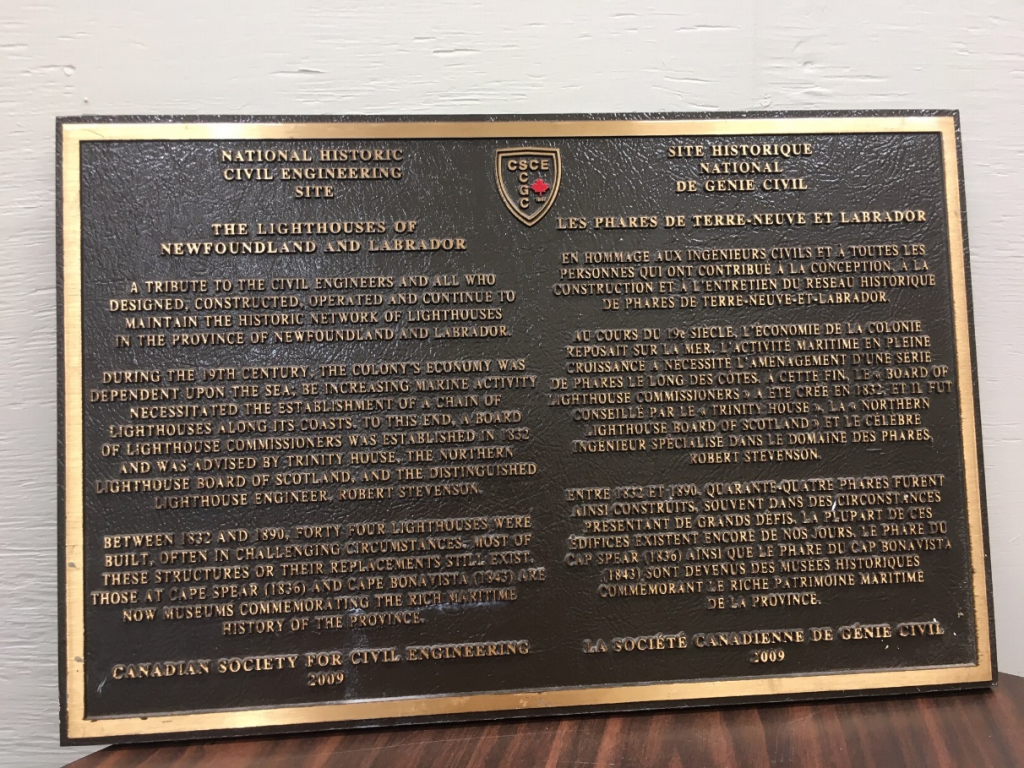
Site Location: Cape Spear Lighthouse. Lat.: 47° – 31’ – 12” N.; Long.: 52° – 37’ – 25” W. (GPS: 47.51994, -52.6235903) Heading south west on Water Street, pass the Railway Coastal Museum and continue 0.8 km. Turn left (east) on Blackhead Road, and follow it for 14.2 km to the lighthouse.
Plaque Location: The plaque is temporarily in storage at the Canadian Coast Guard Alumni Association Art Gallery at Cape Spear. It is hoped that it will soon be mounted outside for public display.
Description: Increasing marine activity during the 19th century necessitated the establishment of a chain of lighthouses along the coast of Newfoundland, then a British colony. A Board of Lighthouse Commissioners was established in 1832 that was advised, from 1874 onwards, by Trinity House, the Northern Lighthouse Board of Scotland, and the distinguished lighthouse engineer Robert Stevenson. Most of these structures or their replacements still exist and those at Cape Spear (1836) (above) and Cape Bonavista (1843) (see International Sites) are now historic museums.


Historic Significance: Lighthouses, built at strategically scattered remote coastal sites, are both technically functional and architecturally beautiful, and so are reminders of our rich maritime history. Before 1910, when Newfoundland was a British colony, nearly all of its economy was dependent upon the sea. At this time, international shipping lanes were also crucial to the Canadian economy. Thus, the demand for safe navigable waters grew, increasing the need for lighthouses along both Newfoundland and Canadian coasts.
The first lightstation in Newfoundland & Labrador was constructed in 1813 at Fort Amherst near “the narrows”, the entrance to St. John’s Harbour. Cape Spear Lighthouse (1836) is the most easterly lighthouse in North America and the oldest surviving lighthouse in Newfoundland and Labrador. The site is a National Historic Site of Canada.

Plaque Wording: CSCE. National Civil Engineering Historic Site. THE LIGHTHOUSES OF NEWFOUNDLAND AND LABRADOR. A tribute to the civil engineers and all who designed, constructed, operated and continue to maintain the historic network of lighthouses in the Province of Newfoundland and Labrador. During the 19th Century, the colony’s economy was dependent upon the sea. The increasing marine activity necessitated the establishment of a chain of lighthouses along its coasts. To this end, a Board of Lighthouse Commissioners was established in 1832 and was advised by Trinity House, the Northern Lighthouse Board of Scotland, and the distinguished lighthouse engineer, Robert Stevenson. Between 1832 and 1890, forty-four lighthouses were built, often in challenging circumstances. Most of these structures or their replacements still exist. Those at Cape Spear (1836) and Cape Bonavista (1843) are now museums commemorating the rich maritime history of the province. Canadian Society for Civil Engineering. 2009.
SCGC. Site Historique National de Génie Civil. LES PHARES DE TERRE-NEUVE ET LABRADOR. En hommage aux ingénieurs civils et à toutes les personnes qui ont contribué à la conception, à la construction et à l’entretien du réseau historique de phares de terre-neuve-et-labrador. Au cours du 19e siècle, l’économie de la colonie reposait sure la mer. L’activité maritime en pleine croissance a nécessité l’aménagement d’une série de phares de long des côtes. À cette fin, le «Board of Lighthouse Commissioners» a été créé en 1832, et il fut conseillé par le «Trinity House», la «Northern Lighthouse Board of Scotland» et le célèbre ingénieur spécialisé dans le domaine des phares, Robert Stevenson. Entre 1832 et 1890, quarante-quatre phares furent ainsi construits, souvent dans des circonstances présentant de grands défis. La plupart de ces édifices existent encore de nos jours. Le phare du Cap Spear (1836) ainsi que le phare du Cap Bonavista (1843) sont devenus des musées historiques commémorant le riche patrimoine maritime de la province.
Plaque Unveiling Ceremony: The plaque was unveiled on May 29, 2009 at Cape Spear Lighthouse by: Guy Gosselin, CSCE President: Jerry Duggan, Canadian Coast Guard Alumni Association, and Ray Browne, A/Assistant Commissioner, Canadian Coast Guard. Alistair MacKenzie, of the CSCE National History Committee and Ray Browne shared Master of Ceremony duties. Reg Wallace, Chair of the CSCE National History Committee described the historic sites commemoration program and Dave Taylor of Parks Canada briefly discussed the history of the lighthouses of Newfoundland and Labrador.
Links to Online Documentation:
Edward F. Bush, “The Canadian Lighthouse”, Parks Canada, 2006.